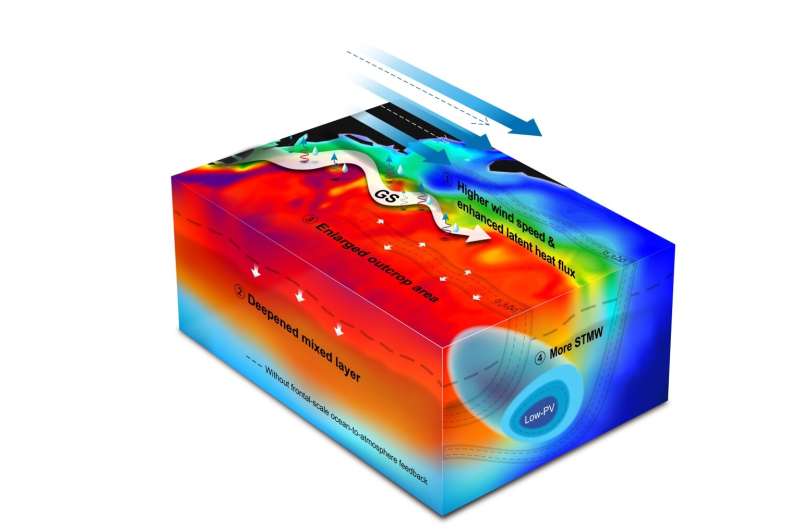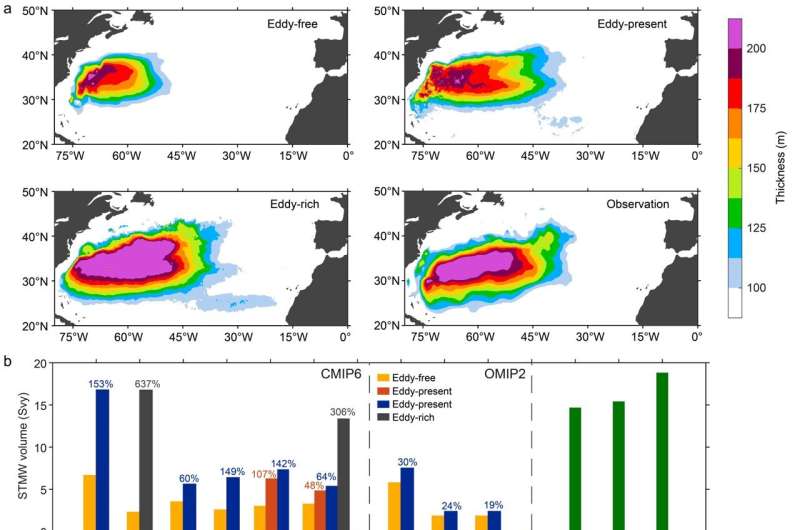Researchers discover Gulf Stream thermal fronts controlling North Atlantic subtropical mode water formation

Subtropical mode water (STMW) is a vertically homogeneous thermocline water mass, serving as heat, carbon, and oxygen silos in the ocean interior and providing memory of climate variability for climate prediction. Understanding physics governing STMW formation is thus of broad scientific significance and has received much attention.
Traditionally, it has been considered that STMW is constructed by basin-scale atmospheric forcing. Due to the limitations resulting from sparse sampling of observations and coarse resolution of climate models, less knowledge is acquired about the role of oceanic thermal fronts in the STMW production.
With a focus on the North Atlantic Ocean, which contains the thickest and volumetrically largest STMW in the global ocean, the team found for the first time that the feedback of sharp surface thermal fronts shaped by the Gulf Stream to the overlying atmosphere is essential for the STMW formation. The paper is published in the journal National Science Review.
By comparing twin simulations conducted with a state-of-the-art eddy-resolving coupled global climate model, it is found that suppressing local frontal-scale ocean-to-atmosphere (FOA) feedback leads to STMW formation being reduced almost by half. This is attributable to a vast increase in surface outcropping associated with the cumulative excessive latent heat release primarily due to higher wind speeds and greater air-sea humidity contrast driven by the Gulf Stream fronts (Figure 1).

Furthermore, the crucial role of the FOA feedback is attested by a multi-model and multi-resolution ensemble of latest global coupled models participating in CMIP6, in which with finer model resolution, the observed STMW is better reproduced due to more realistic representation of FOA feedback (Figure 2). “This is an important finding that incorporates the missing piece for the accurate STMW modeling and provides an effective solution to the common severe underestimation of STMW in earth system models,” Dr. Gan says.
“This study lasted over two years since 2020 and I really enjoyed being part of it. It is a new exciting result that highlights the importance of frontal-scale air-sea interactions in climate system,” Dr. Yu says.
More information:
Bolan Gan et al, North Atlantic subtropical mode water formation controlled by Gulf Stream fronts, National Science Review (2023). DOI: 10.1093/nsr/nwad133
Citation:
Researchers discover Gulf Stream thermal fronts controlling North Atlantic subtropical mode water formation (2023, June 30)
retrieved 30 June 2023
from https://phys.org/news/2023-06-gulf-stream-thermal-fronts-north.html
This document is subject to copyright. Apart from any fair dealing for the purpose of private study or research, no
part may be reproduced without the written permission. The content is provided for information purposes only.
For all the latest Science News Click Here
For the latest news and updates, follow us on Google News.

